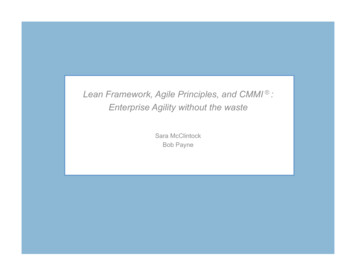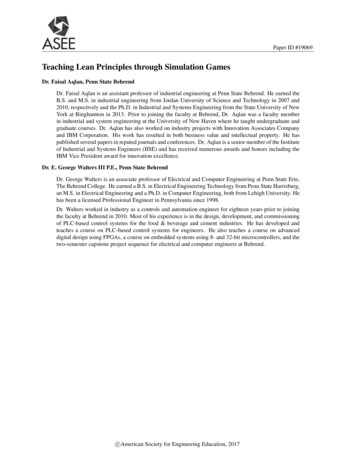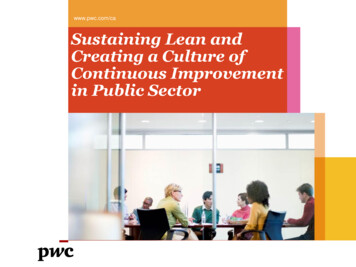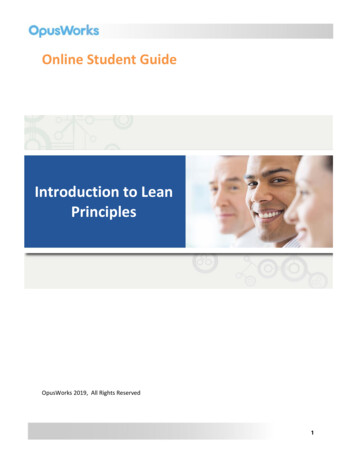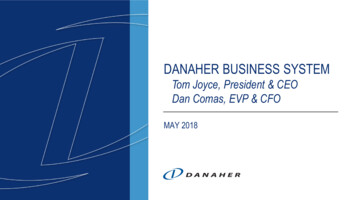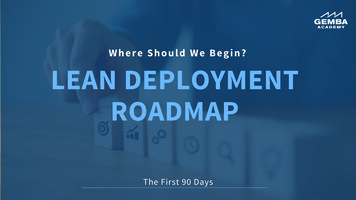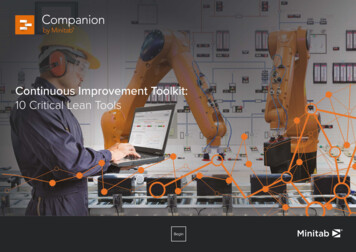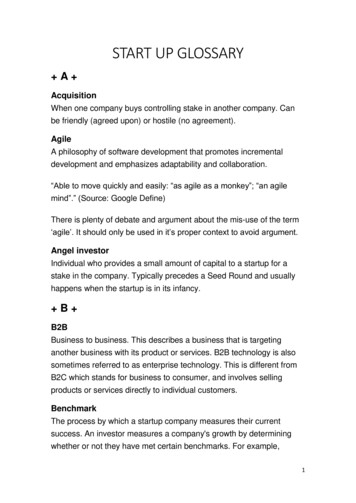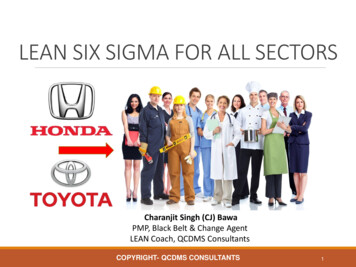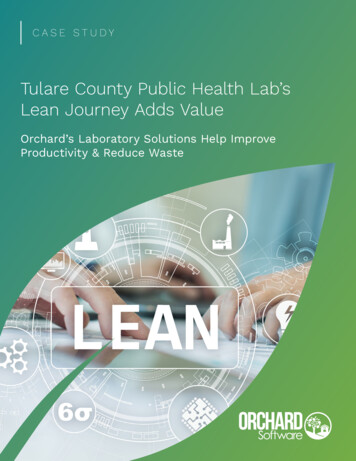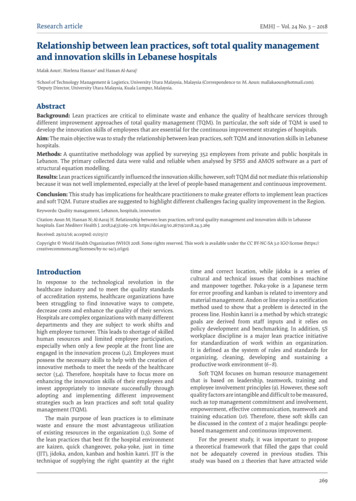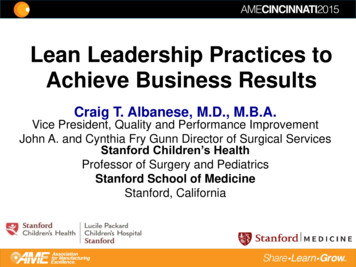
Transcription
Lean Leadership Practices toAchieve Business ResultsCraig T. Albanese, M.D., M.B.A.Vice President, Quality and Performance ImprovementJohn A. and Cynthia Fry Gunn Director of Surgical ServicesStanford Children’s HealthProfessor of Surgery and PediatricsStanford School of MedicineStanford, California1
Learning Goals Understand that a lean leader’s primary job is align theorganization Understand the four lean leadership practices necessaryto achieve long term business results Be able to describe the “ascension paradox” of the leanoperating system Review a 3 year journey to decrease preventable harmin one hospital
Healthcare “challenges” Patient is customerPatient is the product—complex mixed product linesSecondary “products” are traineesEmotional connection requiredMedical/Nursing training teaches disease management not processmanagementDeeper than usual silos in an academic hospital; disconnectedreporting structuresUnusually powerful position of MDs, outside of managementhierarchiesThe mindset that MDs are the internal customers of many processesConservative, evidence-based nature of attitude to changeTruly 24/7 nature of a hospital
Why Lean?ClinicalOutcomes*Experienceof CareValueCostHealthcare reform and consumers demanding:Cheaper, faster, better, safer, kinder for individuals and populations*Patient and Staff Experience
QCDSE Business Results orEnterprise “True North” metricsQ -- QualityC -- CostD -- Delivery (Access)S -- SafetyE -- Engagement/Experience (Patient & Staff)
A lean leader’s primary job is to luesActivitiesLeanBehaviorsProcessesOutcomes QualityCostDeliverySafetyEngagement/Experience
ExtraordinaryPatient CareHighest Quality, Safety and Empathy;Easiest and Timely Access and Lowest CostManagement System/ People Development Refine leadership’s& workforce’sPDCA skills Refine strategydeploymentNo WaitingLevel 5 (optimize)Level 4 (taktenvironment) Innovation toimprove access,cost, empathySet staff cycle timesStaff StandardizedWorkClinical standardizedwork Detail patient flow& lead timesLevelloading Workflow control Control process variationLevel 2(Stability) Establish flow Initiate clinical std workQuality &service stds.Visual managementand problem solvingLeader engagement Customer patientInnovation toimprove quality /safetyVerify at the source Manage tostandardized work &level flowImmediate andonresponseLevel 3 (matchcapacity to demand)Level 1(Foundation)Quality FirstUse andon forprocess stop to meetthe standardSuccessive check Staff todemandSuccessmetricsShared valuesUnderstandcadence (takt)Methods, Equipment, Staffing,Supplies (MESS) 5SValue stream thinking
Frontline feedback that can be addressedwith lean leadership practices “I don’t ever see the senior leadership team members”“Senior leadership doesn’t understand our issues”“We are being asked to change and we don’t know how”“I am overwhelmed by the number of problems we have”“We are overwhelmed by the number of “initiatives” to beworked on” “I ask for help and I rarely get it in time” “The leadership team is always in meetings” “Leadership says they are supportive but I don’t seeevidence of it except they are supporting all of these highpriced consultants”
Leadership Practice One:Goal Alignment/Deployment
CatchballTop Down Themes: Process looks easy –hard to get true alignment Deprioritize work! Room for LODO activitiesCatchball: Negotiation Takes time Better buy-in bettergoalsDevelop the enterprisevision and missionDefine Strategic InitiativesDefine the Core Goalsfor next yearCascade goals to all levelsand functionsExecute monthly process,review, and adjustExecute yearly processreviewsCatchball
Goal Alignment for StanfordChildren’s Health
Core Goals – FY16CategoryQualityServiceAffordabilityInnovation &EducationRespect for PeopleExecutiveOwnersAlbaneseMcCune,RobertsFY16 Core GoalAchieve 2 Quality Metrics in HAC (Healthcare Acquired Condition) aggregate and SSE’s(Serious Safety Events)SSE’s 1 per month, HAC’s 8Ambulatory Care: LTR across specialties to equal 92.3 or above or 80% of specialties(with more than 25 responses) above 92.3Inpatient Pediatrics, OB and Ambulatory Surgery achieve or exceed their FY 15Likelihood to Recommend mean score.HaeringAchieve FY 16 Operating Expense & Capital Budget (where applicable) in each DivisionSandborgImprove manager, physician, and employee effectiveness by developing leaders ascoaches.In FY 16, 200 people managers (including managers, directors, VPs, executives, medicaldirectors and service chiefs) will attend Coaches’ Academy and lead, co-lead orotherwise participate in Quality, Affordability and/or Service improvements in theirrespective areas of responsibility throughout the enterprise.Souza Increase Grand Mean Engagement score by 0.1 point.Reduce the Rate of Injury for all employees to 5.3 per 100 FTE’sImplement 3000 staff/provider generated improvements (STP’s)Situation Target Proposal
Strategic Initiatives –FY16FY 16 Strategic InitiativesExecutiveOwnersInitiative StatementHospital Expansion, Transition andActivationTo deliver a facility that optimizes the hospital’s services andinfrastructure, supports innovation, enhances the patient and familyMcCuneexperience and enables extraordinary care as a top-tier children’shospital.Strategic Partnerships – current,expanded and newRoberts, Be the indispensable pediatric (specialty) partner for leadingLund healthcare systems.Physician network/practices - includesRoberts, Be the ‘must have’ pediatric and obstetric physician practice [orEnterprise Wide Scheduling, EpicLund network].Optimization, TelehealthVision 2025 clinical program initiatives– Centers Of Excellence, othersDevelop programs and services, leveraging our preeminent faculty andstaff, to advance our capability to provide care, create leading researchMcCuneand innovation, and to achieve unparalleled quality, outcomes, serviceand access.Prepare Stanford Children’s Health to participate successfully inAccountable Care – Infrastructure andBrown, current and future accountable care and population healthcapability development for populationSandborg management contracts with commercial payers, large employers, andhealth, complex care managementstate agencies.
Operational Initiatives –FY16FY 16 Strategic InitiativesExecutiveOwnersInitiative StatementBetter patient flow for patients, staff and the organization; today andfor the future.Better Patient FlowAlbanesePCARES PlusPCARES Plus is an enterprise-wide learning platform that governsrespectful, empathic, nurturing and meaningful interactions across theMcCuneentire human experience spectrum to include all staff and physicians,their interactions with each other and with families and patients.
Enterprise Strategic InitiativesVisibility Wall Cross-functional communication Cross-functional accountability Biweekly 30 minute huddle run by CEO, COO ordelegate Invited attendance by C-level, VPs, applicable Directors Initiative owner provides brief status update ( 5 minutes) Focus on reds, with appropriate countermeasures Annual planning process starts & ends with the wallcontents
Leadership Practice Two:Promote ContinuousImprovement
Value stream flow Patient ansport
Focus on the X’s not the YY is the outcomewe wantX’s are the processes/drivers thatneed to be controlled to get the zed WorkStd work and DMS are how to control the X’sDaily Management
Using standards as problemsolving tools Make issues (abnormalities) visible by implementingstandards and measuring the actual output against theexpected output Then do PDCA to solve the issues at their root (incontrast to quick countermeasures) so that they don’tcontinue to reduce efficiency This approach requires leaders to be very tenaciousabout continuously applying the PDCA cycle
A Daily Management SystemSustains the Improvements
Components of Daily ManagementDMS PrincipleDefinitionReliable Method/Standardized WorkA documented procedure (i.e. how to) with sequence, supplies and quality toll gates,owned by a named individual, used by everyone. When the element of time is added, itis deemed Standardized Work.Reliable Method or StandardWork Audit/CheckA structured check of the process to ensure Reliable Method is followedAbnormality & AndonA system to immediately notify appropriate management, maintenance, providers andother team members of a safety, quality, process or problem requiring acountermeasure. May involve abruptly stopping a process.Continuous improvement process generated and implemented by the frontline, withassistance and coaching from leadership. STP Situation, Target, Proposal.A strategy for creating, supporting, and sustaining process stability through the use ofvisual cues.Problem Solving:Improvement Ideas (STPs)Visual ManagementTiered HuddlesAndon ResponseBrief, structured, stand-up meetings used to review area readiness and identifyproblems.A tiered system to immediately respond to an andon. Involves team leads and a varietyof managers. Quick countermeasure and root cause problem solving requiredLeader Standardized Work:Responsibilities for LeadersA working document (checklist) for leaders specifying the actions to be taken each dayto focus on the processes in that leader’s area of responsibility.Leader Gemba WalkEach level leader above the work unit routinely observes the workplace with thedepartment leader/student for the purpose of supporting the work processes
Leadership Practice Three:Develop Self
Servant Leadership Practices Communicate vision: what is ideal future state, createdissatisfaction with current stateAppeal to head (intellect) and heart (emotions) Walk the Talk—go see reality at least once a week Humble inquiry Listen more than talk Engage the frontline workers: What is getting in your wayof doing your job? Review metrics with area management Foster value stream thinking: build span of supportversus span of control (authority v responsibility) Celebrate the wins
Leader Standardized Work Calendar gemba time: used for time with direct reportsand observing the real work in the hospital/clinic. Nocross-functional meetings Debrief gemba walks at team meetings Attend weekly improvement report outs Attend daily Ops huddle Sponsor improvement event Participate improvement event Construct and own an A3 Complete STPs (Situation, Target, Proposal)
Traditional ManagementLean ManagementFocus on outcome (“get results”)Focus on standardized processes that get the desiredoutcomeAttaining goals trumps all elseDeveloping people has equal weight to goal attainmentManage to industry benchmarksManage to customer requirementsMetrics visible to fewMetrics visible to allBatch and retrospectively review resultsReal time and prospective view of data/resultsManagement tells staff what to doManagement questions, challenges, coaches and offershelp to staffManage from officeManage in gembaProblems are badProblems are treasuresWho produced the error?What suboptimal work process(es) or system producederrorAutocratic, top-down problem solvingGuided, distributed, participative problem solvingAutocratic, top-down goal creationGuided, distributed, participative goal creationOrganizational success attained by time-intensiveanalysis and design of “perfect fix”Success through continuous, rapid, small, incrementalimprovements
Leadership Practice Four:Develop Others
Creating a strong air campaign1. Pit the vision of where you want to be against the realityof the current state to the organization2. Educate and engage the workforce through:1. Point improvements2. Lean pedagogy3. End of week improvement report outs4. Plethora of varied communication methods5. Lean learning trips and networking
Create a strong groundcampaign1. 3 Actuals Walk2. Make good practices easier to do-Calendar gemba time, improvement time3. Make bad practices harder to do-Decrease meeting times, emails, outside interferences,etc 4. Reduce the choices of what to work on“A” items, “B” items, “C” items5. Make losers whole6. Emphasize succession planning and leader development
Gemba Coaching KataQuestions(Mike Rother, Toyota Kata)1. What is the target condition?2. What is the current condition?3. What obstacles are preventing you from reachingthe target condition?4. Which one are you working on now?5. What is your next step?6. When can we go and see what we have learnedfrom taking that step?Key concept: Coaching asking, not telling
Ascension Paradox of theLean Operating System Want to get to Level 5 as quickly as possible (biggestcost down and quality increases) Latent problem: real work is at foundational level 1(alignment/understanding) Level 1, if done correctly, takes time, patience, learningto “walk” again, and is difficult No real QCDSE gain at during level 1 work
LeanLevelsQuality /SafetyCostReductionLevel 5MistakeproofLevel 4Self-inspect30%Level 3Unitinspects10%Level 2Inspect @discharge5%Level 1Patientinspects0%45%LeadershipEffortConsistent PatientExperience
ExtraordinaryPatient CareHighest Quality, Safety and Empathy;Easiest and Timely Access and LowestCostManagement System /People DevelopmentNo WaitingLevel 5 (optimize)Level 4 (taktenvironment) Level 3 (matchcapacity todemand)Level 2(Stability)Level 1(Foundation) Innovation toimprove access,cost, empathy Set staff cycle timesStaff StandardizedWorkClinical standardizedwork Refine leadership’s& workforce’sPDCA skillsRefine strategydeployment Manage tostandardized work& level flowImmediate andonresponse Detail patientflow & lead timesLevelloading Workflow control Control processvariation Establish flow Initiate clinical stdworkQuality &servicestds.Visual managementand problem solvingLeader engagementQuality FirstInnovation toimprove quality /safetyVerify at the source Use andon forprocess stop tomeet the standardSuccessive check Staff todemandSuccessmetricsCustomer patient Shared valuesUnderstandcadence (takt)Methods, Equipment,Staffing, Supplies (MESS) 5SValue stream thinking
How do we go faster?The role of leaders Alignment, alignment, alignment Link to strategic/ops plan: “What do we have to do?” Decommission work! Develop improvement capability in ops (not just PI team) Management system: tenacity Value stream management: adjudicate responsibility vauthority tensions Make the big decisions
Example of Faster:Periop Work GroupOn July 31st 2015, the 3:15 Periop Scheduling Meeting ran for over 1 hour, due tosorting and accommodating bed requests for following day of surgery. Consensus wasthat another meeting needed to be scheduled earlier to confirm, organize, andaccommodate all OR bed requests. Following the initiation of this daily huddle, aPeriop Work Group formed to create a solution to manage the OR schedule further inadvance in order to decreasing delays and cancellations, overburdening staff, andgoing through extraordinary measures to accommodate our scheduled cases.Aug 3rdSept 8thAug 17thInitiation ofSchedulingMeetingSurgical CapImplementationMeetingAug 20thFuture State CapImplementation& RescheduledCases MeetingAug 26th T-1 Level LoadingMeeting: TrialProcessAug 31stGO LIVE T-1 Level LoadingMeeting: FinalizedProcess1. LevelLoading DailyTimeline2. SurgeryScheduler DailyBulletin
A Business Problem We averaged over 3 serious safety events per month Most are preventable
Leaders’ Actions to Decrease SSEs Align organization around the problem: “Do we agree?” Deploy as an annual goal for all work areas Deprioritize work Support roll out of standardized processes, wasteelimination, blend into our management system, PDCA Develop self: humble inquiry, review process metrics Develop others: coaching kata, tenacity
Escalating Safety ProblemsTier 1a: 0700/1900Charge RN and staffTier 2: 10:15Managers and DirectorsTier 1b: 0800Charge nurse(s) and managersTier 3: 10:30Directors and VPs
Culture of Safety Survey (AHRQ)Question DescriptionMy supervisor/manager says a good word when he/shesees a job done according to established patient safetyproceduresThe actions of hospital management show that patientsafety is a top priorityWe are actively doing things to improve patient safetyMy supervisor/manager seriously considers staffsuggestions for improving patient safetyIn this unit, we discuss ways to prevent errors fromhappening againWhen a mistake is made, but has no potential to harm thepatient, how often is this reported?After we make changes to improve patient safety, weevaluate its effectivenessMistakes have led to positive changes hereWhen a mistake is made that could harm the patient, butdoes not, how often is this reported?Hospital management provides a work climate thatpromotes patient safetyStaff feel free to question the decisions or actions of thosewith more 772%76%4%0.047443%47%4%0.0479
Organization Wide Effort54% Decrease!Serious Safety Event Counts By Month9Pre-Intervention87InterventionSSE hSSE CountUCL 2 Sigma 1 SigmaAverage-1 Sigma-2 SigmaLCL
Role of LeadersPromote sServant LeadershipVPsCEOSupport Continuous ImprovementCommunicate“Go See”Remove Barriers
Role of Lean vitiesLeanBehaviorsProcessesOutcomes (Business Results) QualityCostDeliverySafetyEngagement/Experience
Thank You!Please complete the session survey at:www.ame.org/surveySession: TP/06Achieving Business ResultsCraig AlbaneseStanford Children’s Healthcalbanese@stanfordchildrens.org
Lean Leadership Practices to Achieve Business Results Craig T. Albanese, M.D., M.B.A. Vice President, Quality and Performance Improvement John A. and Cynthia Fry Gunn Director of Surgical Services Stanford Children’s Health Professor of Surgery and Pedi
